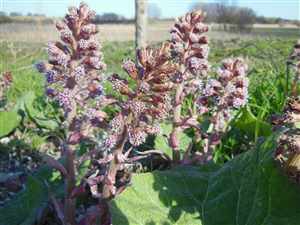Butterbur (Petasites hybridus, Petasitidis hybridus, Petasites officinalis, Tussilago hybrida)
Main Facts about Butterbur

Using Butterbur
According to test tube and animal studies, Butterbur contains chemicals (called petasins) that relax blood vessels and various smooth muscles in the body, such as those that are found in the uterus and lungs. Petasisn also known to relieve spasms and decrease swelling (inflammation). Because of these properties, Butterbur might be expected to be beneficial for people with migraines and asthma. Butterbur extracts have consistently been shown to reduce symptoms in people with migraines more effectively than placebo. Butterbur has also been shown to help people with asthma, although the results have been conflicting. There is some evidence that butterbur extract can decrease the symptoms associated with hay fever without causing drowsiness. Butterbur also contains unsaturated pyrrolizidine alkaloids. These can cause severe liver damage in some people if taken for too long. Only extracts that exclude pyrrolizidine alkaloids should be used.Caution!
Do not take if pregnant or breast-feeding. Do not take if allergic to ragweed, marigolds, daisies, and other related herbs. Do not take if you have liver disease. Do not use butterbur products unless they are certified and labeled as free of PAs that cause liver damage.Cooking with Butterbur
The leaves, rhizomes (underground stems), and roots of butterbur are commonly used to make solid extracts used in tablets that contains 7.5 mg of petasine per capsule. Intake is usually 1 to 2 capsules three times per day. Some butterbur extracts are also used topically. As an herbal tea: Put 1 teaspoonful of the root in a cup of water and bring to the boil. Simmer for 10-15 minutes. Drink the tea three times a day. As a tincture: Take 1- 2 ml of the tincture three times a day.How to grow Butterbur
Butterbur typically grows in shady places or beside waterways. It also grows well in wet meadows, copses, marshes, flood plains, washes, and damp roadsides.| Butcher's Broom |
Calendula
|